In the contemporary corporate landscape, the significance of customer experience cannot be overstated, particularly for online retail businesses. Beyond merely offering top-notch products at competitive prices, providing excellent customer service has emerged as a pivotal factor in determining success.
Enter conversational commerce, also referred to as chat commerce or conversational marketing—a pioneering approach that empowers online companies to leverage conversations as a means to market and sell their products and services. This innovative strategy enables businesses to engage with their customers directly, fostering a more personalized and interactive relationship.
According to studies, global expenditure on conversational commerce channels is projected to exceed USD 290 billion by 2025, underscoring its growing importance in the digital marketplace. With this in mind, let’s explore how your company can harness the power of conversational commerce to elevate customer interaction and drive sales.
What is Conversational Commerce?
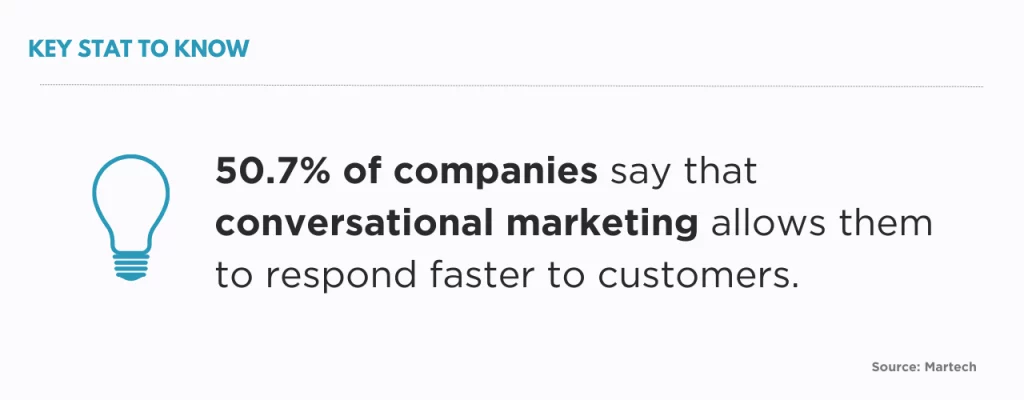
Conversational commerce represents a paradigm shift in the way online businesses engage with customers throughout the digital purchasing journey. Unlike traditional methods that rely on intrusive pop-ups or banners, conversational commerce prioritizes authentic conversations aimed at fostering stronger relationships.
At its core, conversational commerce leverages chat and messaging applications to facilitate real-time interactions and transactions with consumers. These conversations can occur across various platforms, including popular messaging apps like WhatsApp, chat widgets embedded on websites, and SMS channels. Whether mediated by chatbots or human agents powered by artificial intelligence, the primary objective is to assist customers in making informed purchase decisions seamlessly.
The overarching goals of conversational commerce encompass the following:
- Personalization: Tailoring the shopping experience to individual customer preferences and needs through personalized assistance and guidance.
- Sales facilitation: Streamlining the purchasing process by providing timely reminders and live chat support to address any queries or concerns that may arise.
- Marketing: Introducing customers to new products and services through targeted recommendations and promotional messages.
- Post-purchase support: Offering ongoing assistance and guidance even after the completion of a transaction to ensure customer satisfaction and loyalty.
Key Statistcs:
- By 2025, global spending on conversational commerce channel is expected to exceed USD 290 billion, highlighting its rapid growth and adoption in the retail sector.
- A survey conducted by Business Insider Intelligence revealed that 75% of customers expect assistance within five minutes of reaching out to a brand via messaging apps.
- Research by Statista indicates that 53% of consumers are more likely to shop with a business they can message directly.
Benefits of Conversational Commerce:

- Reducing Cart Abandonment: Cart abandonment is a key challenge for eCommerce businesses, with the average abandonment rate estimated to be around 70.19%. Conversational commerce addresses this issue by identifying the underlying reasons for abandonment, such as high shipping costs or a complex checkout process, and providing timely solutions. Through real-time interactions, businesses can engage with customers to address concerns and encourage them to complete their purchases.
- Closing Potential Leads: Conversational commerce platforms empower customers to explore offers and make informed decisions. By deploying chatbots on checkout pages and customizing live chat greetings, businesses can provide personalized assistance and guidance to customers, helping them navigate through the purchasing process seamlessly. This proactiveness not only enhances the customer experience but also increases the likelihood of closing potential leads.
- Offering Post-Purchase Support: Conversational commerce solutions enable companies to engage with customers who may require additional assistance post-purchase. Whether it’s resolving issues, providing product recommendations, or soliciting feedback, businesses can leverage organic dialogues to maintain ongoing communication with customers and ensure their satisfaction. By offering comprehensive support throughout the customer journey, companies can build trust and loyalty among the customer base.
- Upselling and Cross-Selling: Conversational commerce presents opportunities for upselling and cross-selling by delivering personalized product suggestions through real-time conversations. By leveraging messenger chatbots and AI-powered assistants, businesses can engage with customers to promote related items or alternatives, thereby increasing revenue and maximizing the value of each transaction.
- Building Customer Loyalty: By providing personalized assistance and support at every touchpoint, businesses can forge stronger connections and instill confidence in their customers. Whether it’s through chatbots sharing promotional offers or voice assistants offering assistance, conversational commerce helps businesses foster loyalty and affinity among their customer base. By delivering exceptional experiences and value-added services, companies can differentiate themselves from competitors to cultivate long-term relationships with customers.
Real Life Examples of Conversational Commerce:
1. Sephora
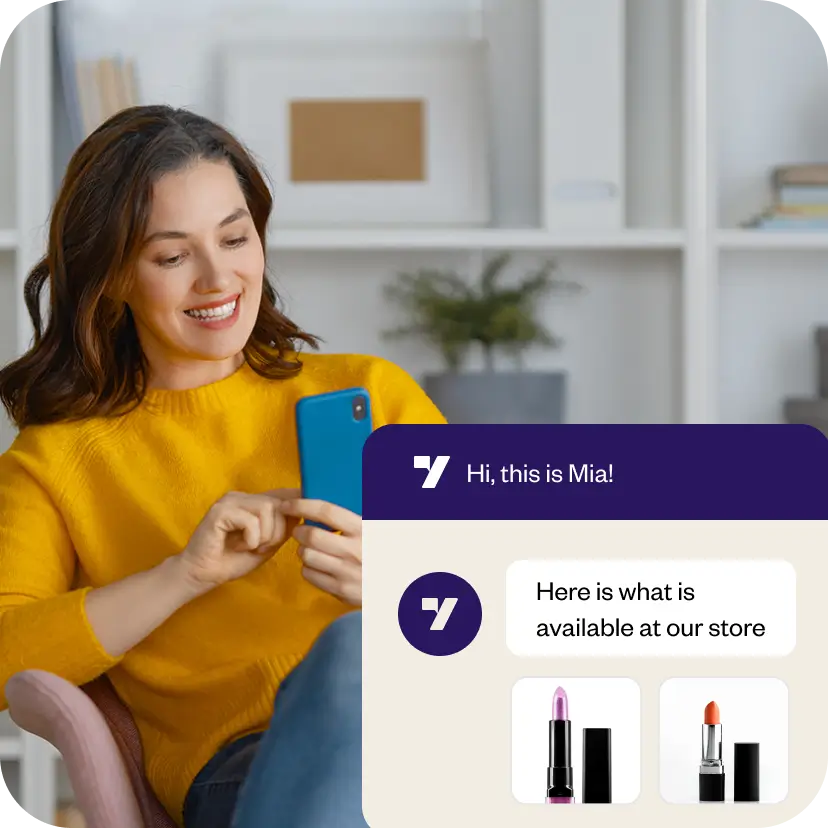
Sephora, a renowned beauty retailer, has embraced conversational commerce to enhance the shopping experience for its customers. One of its notable initiatives involves the deployment of a makeup bot on the messaging platform Kik. This innovative approach allows Sephora to offer personalized product recommendations tailored to each user’s preferences.
Key Features:
- Customized Product Recommendations: The makeup bot on Kik utilizes advanced algorithms to analyze user preferences and behavior, enabling it to generate customized product recommendations. By understanding each customer’s unique needs and preferences, Sephora can deliver personalized suggestions that resonate with individual users.
- Interactive Quizzes: Sephora’s makeup bot engages customers through interactive quizzes designed to uncover their beauty preferences, skin type, and desired makeup looks. These quizzes serve as a fun and interactive way for customers to explore different products and discover new beauty trends.
- Product Evaluations and How-To Videos: In addition to product recommendations, Sephora’s makeup bot provides customers with valuable resources such as product evaluations and how-to videos. These educational materials help users make informed purchasing decisions by providing insights into product performance, application techniques, and beauty tips.
- Seamless Purchasing Experience: By integrating purchasing capabilities directly into the Kik platform, Sephora enables customers to complete transactions without leaving the app. This streamlined approach simplifies the purchasing procedure and encourages impulse buying, ultimately driving sales and revenue for the company.
2. H&M
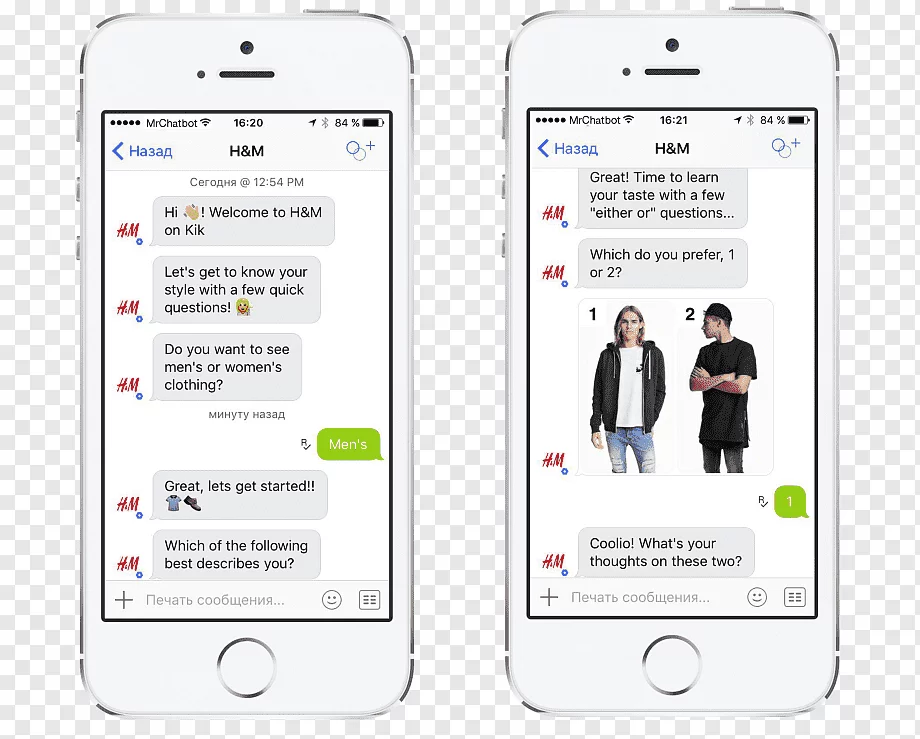
H&M, a global fashion retailer, has also leveraged conversational commerce to enhance the shopping experience for its customers. Through its collaboration with Kik, H&M has deployed a chatbot that acts as a personal stylist, offering personalized product recommendations based on each user’s preferences.
Key Features:
- Personalized Recommendations: H&M’s chatbot on Kik interacts with customers to gather information about their tastes, preferences, and style preferences. Using this data, the chatbot delivers personalized product recommendations tailored to each user’s individual fashion preferences.
- Streamlined Shopping Experience: H&M’s chatbot acts as a virtual personal stylist, guiding customers through the shopping process and helping them find the perfect items to suit their style. By streamlining the shopping experience, the chatbot saves customers time, making it easier for them to discover new fashion trends and make purchases.
- Real-Time Assistance: In addition to providing product recommendations, H&M’s chatbot offers real-time assistance to customers, answering questions, addressing concerns, and providing support throughout the shopping journey. This personalized assistance improves the overall customer experience and helps build trust and loyalty with H&M’s customer base.
- Integration with Social Platforms: By integrating with popular messaging platforms like Kik, H&M’s chatbot meets customers where they are, allowing them to shop and interact with the brand seamlessly within their preferred messaging app. This omni-channel approach ensures a consistent and cohesive shopping experience across all touchpoints, driving engagement and customer satisfaction.
3. Starbucks

Starbucks has introduced a revolutionary smart barista bot aimed at revolutionizing the coffee ordering experience. This innovative solution is designed to minimize customer wait times and streamline the process of ordering and paying for coffee. Key features of the smart barista bot include:
- Order Efficiency: The smart barista bot allows customers to place their orders seamlessly, reducing wait times and enhancing overall efficiency.
- Payment Integration: Customers can conveniently pay for their orders directly through the bot, eliminating the need for cash or card transactions at the counter.
- Notification System: Once the order is placed, customers receive instant notifications when their coffee is ready for pickup. This ensures immediate service without the hassle of waiting in line.
- Personalization Options: The bot offers personalized recommendations based on customer preferences, allowing for a tailored coffee-ordering experience.
- Accessibility: The smart barista bot is accessible via various platforms, including mobile apps and social media channels, making it convenient for customers to place their orders anytime, anywhere.
4. WHO
The World Health Organization (WHO) has leveraged chatbots to provide accurate and up-to-date information on the COVID-19 pandemic across social media platforms such as Facebook Messenger and WhatsApp. Key features of WHO’s chatbot initiative include:
- Multilingual Support: The chatbots support more than 19 languages, ensuring that a diverse range of individuals can access critical health information regardless of their language proficiency.
- Information Dissemination: The chatbots deliver timely updates, guidance, and resources related to COVID-19, helping to educate the public and combat misinformation.
- Accessibility: The chatbots are accessible to users worldwide, including those with low reading levels or limited access to traditional healthcare resources.
- Interactive Features: Users can engage with the chatbots to ask questions, receive personalized recommendations, and access relevant resources, enhancing the overall user experience.
- Real-time Updates: The chatbots provide real-time updates on pandemic-related developments, ensuring that users have access to the latest information to make informed decisions about their health and safety.
Learn how to integrate chatbots in WP here.
5. Instacart
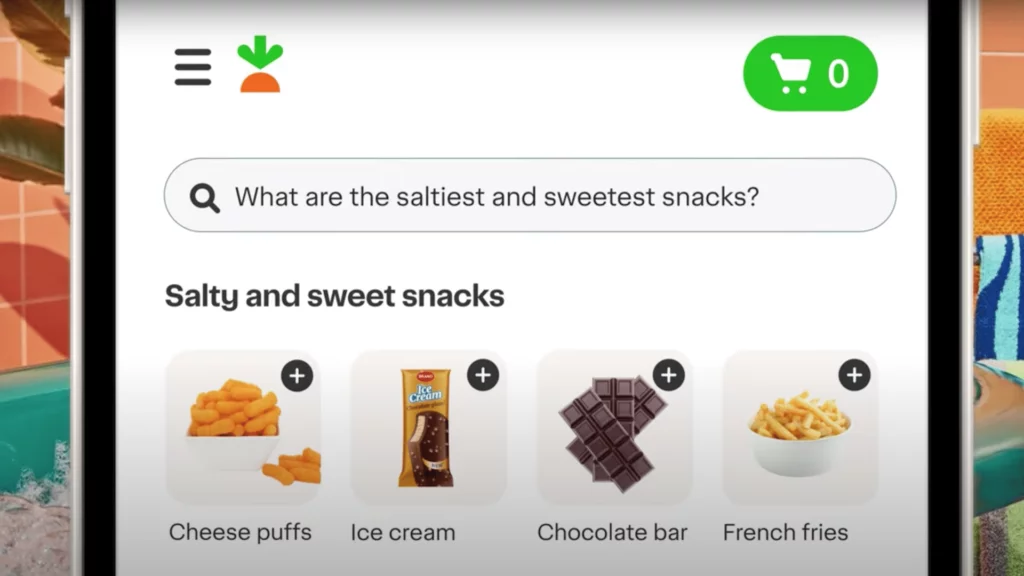
Instacart has implemented a comprehensive approach to enhance the customer experience through several features and functionalities. Key aspects of Instacart’s strategy include:
- Customer Surveys: Instacart employs customer surveys to gather feedback and insights, allowing them to better understand customer preferences and improve service quality.
- Tailored Offers: Instacart provides personalized offers and promotions based on individual shopping habits and preferences, enhancing customer satisfaction and loyalty.
- Delivery Notifications: Customers receive timely notifications regarding the status of their orders, including updates on delivery times and any potential delays, ensuring transparency and peace of mind.
- SMS Order Confirmations: Instacart utilizes SMS order confirmations to provide customers with instant confirmation of their orders, reducing uncertainty and increasing trust in the service.
- Two-Way Real-Time Communication: Instacart facilitates two-way real-time communication between customers and support representatives, allowing for prompt responses to inquiries and issues, thereby improving overall customer satisfaction and experience.
6. Dominos
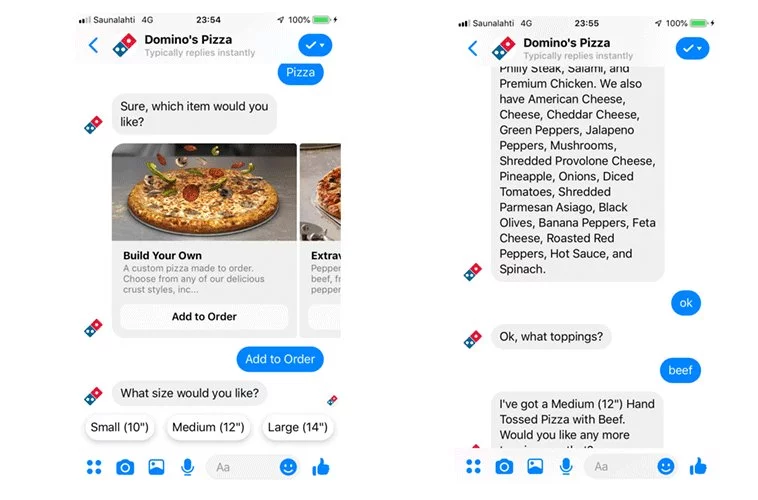
Domino’s has introduced the Domino’s AnyWare initiative to streamline the ordering process and offer tailored experiences across multiple channels of contact. Key features of Domino’s AnyWare initiative include:
- Ordering via SMS, Slack, or Facebook Messenger: Domino’s allows customers to place orders conveniently through various messaging platforms, including SMS, Slack, and Facebook Messenger, providing flexibility and convenience.
- Frictionless Ordering: By reducing friction in the ordering process, Domino’s aims to increase conversions and enhance the overall customer experience, enabling customers to place orders seamlessly.
- Personalized Recommendations: Domino’s leverages customer data and preferences to provide personalized recommendations and offers, catering to individual tastes and preferences.
- Multi-Channel Accessibility: Domino’s AnyWare initiative offers customers the flexibility to order from their preferred channel of communication, ensuring accessibility and convenience for all users.
- Enhanced Customer Experience: By offering seamless and personalized ordering experiences across multiple channels, Domino’s aims to improve customer satisfaction and loyalty, driving repeat business and revenue growth.
7. Netflix

Netflix employs an interactive approach to engage with users and provide personalized recommendations and updates. Key features of Netflix’s strategy include:
- Interaction via WhatsApp: Netflix interacts with users through WhatsApp, allowing for direct communication and engagement with subscribers.
- Content Suggestions: Netflix provides personalized content suggestions and recommendations based on user preference and viewing history, enhancing the user experience and increasing engagement.
- Notification of New Episodes: Netflix notifies users about new episodes and releases, ensuring that subscribers are aware of the latest content additions and updates.
- Proactive Distribution of Material: By proactively reaching out to subscribers and distributing relevant material, Netflix aims to increase client retention and engagement, ultimately driving platform usage and satisfaction.
- Improved Client Retention: Netflix’s interactive approach helps to foster a sense of community and engagement among subscribers, leading to improved client retention and loyalty.
Steps to Integrate Conversational Marketing:
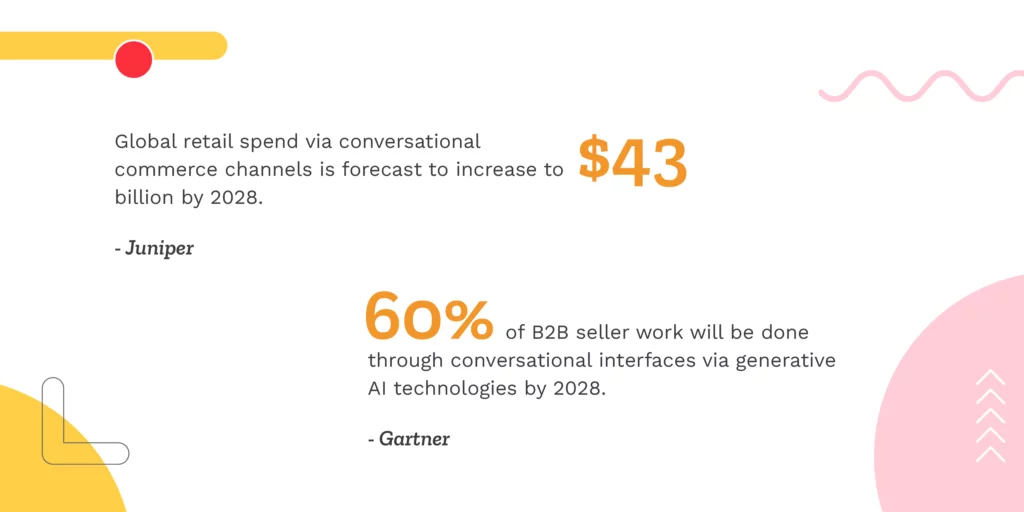
Implementing conversational commerce in your eCommerce business involves several steps, each crucial for its successful integration. Here’s a detailed guide along with plugins and tools to help you through the process:
Step 1: Evaluate its Benefits
Before diving in, assess how conversational commerce could benefit your business. Research its potential applications, such as product recommendations, customer support, and direct transactions. Utilize tools like Google Analytics and customer feedback surveys to understand your audience’s preferences and needs.
Step 2: Choose Communication Channels
Carefully select communication channels that align with the target audience and business goals. Consider options like email, SMS, social media messaging platforms (Facebook Messenger, Instagram Direct), and website chat widgets. Tools such as Intercom, Zendesk Chat, and LiveChat offer versatile communication options across multiple channels.
Step 3: Select a Communication Tool
Based on your chosen channels, decide on a communication tool that enables seamless interactions. You can opt for comprehensive CRM software like HubSpot or Salesforce, which integrates various messaging channels and provides robust conversation management features. Alternatively, standalone AI chatbot platforms like Drift, Chatfuel, or ManyChat offer automated interactions and real-time assistance.
Step 4: Design Conversational Pathways
Once you’ve selected a communication tool, craft conversational pathways that align with your customer journey. Utilize plugins and tools provided by your chosen platform to design welcome messages, input prompts, and responses to frequently asked questions. Consider incorporating plugins like chatbot builders, AI-powered analytics, and integrations with eCommerce platforms for enhanced functionality.
Step 5: Test and Troubleshoot
Before launching, thoroughly test your conversational commerce setup to identify any potential issues or areas for improvement. Use testing plugins like Testomato or Ghost Inspector to ensure functionality across different platforms and devices. Address any glitches or inconsistencies to provide a seamless experience for your customers.
Step 6: Monitor Performance and Optimize
Once your conversational commerce strategy is live, monitor its performance using relevant metrics and KPIs. Tools like Google Analytics, Hotjar, or Mixpanel can help track customer satisfaction ratings, response times, conversion rates, and engagement levels. Analyze the data collected to identify the trends, areas for improvement, and optimization opportunities. Continuously tweak your strategy and leverage plugins for A/B testing, personalization, and automation to enhance effectiveness over time.
Conclusion:
By 2028, an estimated 60% of B2B sellers are projected to adopt conversational interfaces powered by generative AI technology. This forecast underscores the growing significance of voice assistants, chat applications, and bots in commercial activities, indicating their indispensable role in modern business operations. Leveraging conversational commerce offers numerous advantages for brands leveraging real-time communication capabilities.
Conversational commerce facilitates the establishment of enduring relationships with customers while simultaneously marketing and selling products. Recognizing consumers’ preference for convenience and time efficiency, providing them with personalized support can enhance their shopping experience significantly. These marketing strategies have the potential to yield substantial returns on investment by effectively addressing customer needs.
What distinguishes conversational marketing from conversational commerce?
- Conversational marketing focuses on engaging and nurturing leads through personalized, real-time conversations, primarily for marketing purposes. It aims to initiate and facilitate conversations with potential customers, driving brand awareness, engagement, and ultimately, conversions.
- Conversational commerce, on the other hand, extends beyond marketing to encompass the entire sales process, from product discovery to post-purchase support. It leverages conversational interfaces to enable seamless transactions, provide customer assistance, and foster long-term relationships, ultimately driving sales and revenue.
3. What difficulties does conversational commerce present?
- Integration Complexity: Implementing conversational commerce solutions often requires integrating various communication channels, AI technologies, and backend systems, posing challenges in terms of technical complexity and compatibility.
- Privacy Concerns: Collecting and processing customer data through conversational interfaces raises privacy and security concerns, necessitating robust data protection measures and compliance with regulatory requirements such as GDPR.
- User Experience: Ensuring a smooth user experience across different devices and platforms is critical for the success of conversational commerce initiatives. Designing conversational pathways and interfaces that effectively guide users through the sales process while addressing their needs and preferences is a significant challenge.
- Scalability: As businesses scale and customer demand increases, maintaining the efficiency and effectiveness of conversational commerce solutions becomes challenging. Ensuring scalability requires ongoing optimization, resource allocation, and investment in infrastructure and technology.



